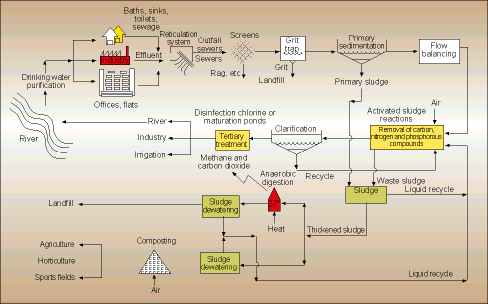
Sewage treatment due to homo sapiens modern actions is a 24 h process, although the levels of wastewater being produced will fluctuate throughout the 24 h cycle.
Raw sewage water (process water) enters the typical sewage treatment plant containing solids of various sizes which at that point get removed from the system by screens. The process water then passes through a de-gritting system and the process water flow is measured and quantified using an ultrasonic flowmeter.

PST
From the de-gritters the process water is gravity fed to the primary sedimentation tanks (PST) where the first process treatment starts. At the PSTs most of the remaining suspended solids are removed by the process of sedimentation. The heavier solids (sludge) precipitate to the bottom of the tank where these are cyclically extracted. The frequency of the cycles will depend on the quantity of the sludge over a 24 h period. The sludge is gravity fed to the thickener process (see sludge elutriation) where it is measured and quantified using a magnetic flowmeter. The settled sewage water runs over the edge of the PST into a balancing tank which acts as a flow buffer.
From the balancing tank, the settled sewage water is fed into a biological reactor (bioreactor) where the carbon, nitrogen and phosphorous compounds are removed through a biological process.
Bioreactor
The bioreactor consists of several zones which perform specific functions:
* First anoxic zone (only bound oxygen available in this zone).
* Anaerobic zone (no free or bound oxygen available).
* Second anoxic zone (only bound oxygen available).
* Aeration zone.
(These zones are as per the process adopted in Johannesburg.)
The first zone (anoxic zone also called the S-recycle) receives the settlement from the secondary sedimentation process (SSTs). This acts as seeding to start the biological process. The SST is similar in function to the PSs.
The first anoxic zone consists of mixers that keep the solids in suspension, at the same time process water is pumped back from the anaerobic zone (B-recycle) to the first anoxic zone. In the aeration zone, the process water is aerated by mechanical aerators that physically throw the water into the air to introduce air. The oxygen levels are kept between 2 and 3 mg/l.
From zone 4 the process water overflows into the secondary sedimentation tanks (SST) where the remaining biomass is removed using the same principle as in the PSTs. The biomass is returned to the bioreactor via screw pumps.
The cleaned process water (effluent) that overflows from the SST is disinfected to kill harmful bacteria either using chlorination, or it is fed/pumped to water maturation dams that are designed to expose the water to UV light from the sun for a number of days. Once the harmful bacteria are removed the water is fed back into the river system, which will eventually run to the normal catchment areas.
Returning to the sludge that is extracted from zone 4 in the bioreactor. At various zones, as selected by the process engineer, ferric chloride is dosed in an effort to precipitate phosphates from the system if the load is too high to be removed by the biomass.
From zone 4, approximately a metre from the top of the tank, waste activated sludge (WAS) is extracted via a modulating valve, the quantity depending on the sludge age and temperature. The flow of extracted sludge is measured here with an ultrasonic level instrument that is calibrated to indicate flow as function of height through a Parshall flume.
Sludge elutriation
The sludge from the PSTs is thickened and then pumped to the anaerobic digesters. The thickening process consist of two systems, the first recycles the sludge while filling the tank, and the second system recycles and pumps the sludge to the anaerobic digesters.
Anaerobic digesters
The digesters make use of an anaerobic process where the sludge is broken down; a by-product of this process is methane gas which is collected and used to fuel boilers that are used to keep the digesters at a constant temperature of 34-37°C.
The output from the digesters is an inert sludge that is pumped to a dewatering plant where polymers are added to extract water. The water is then returned to the bioreactor. The dry sludge, mixed with bulking agent, is biologically broken down and used as compost. The complete composting process takes approximately three weeks to complete. From the moment, that raw sludge enters the process, until the final treated water exits the plant takes 7-12 days.
The complete process is automated and controlled by programmable logic controllers, flowmeters, temperature instruments, dissolved oxygen meters, pH meters, magnetic flowmeters, ultrasonic level transmitters. The status of the plant is monitored by a scada system that generates reports of daily and monthly flows, average temperatures and energy.
WSP developed special algorithms for balancing tank control, aeration DO control and sludge age control in the bioreactor. WSP has successfully completed numerous wastewater treatment plants for the Greater Johannesburg Metropolitan Council.
WSP Projects
(011) 803 7920

© Technews Publishing (Pty) Ltd | All Rights Reserved